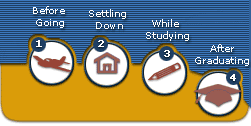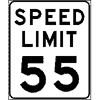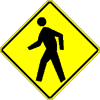 |
 |
 |
 |
 |
 |
 |
| Privacy Policy |
| Disclaimer |
| Terms & Conditions |
|
The Joy of Driving in America: Reading signs and dodging people by David Shen Driving is very important for the far-away-from-home international students who live on the West Coast of the United States. If you cannot drive, you restrict your living space to the area near your school, and you have to 'beg' your classmates to give you a ride when you want to leave that small living circle. Recently my wife came to the United States to join me. She was an experienced driver in Taiwan, but she still found driving in the U.S. frustrating and uncomfortable. She even began to doubt her ability to drive well. She had to count on my driving her to go shopping, to go to school and to go to any other places that she couldn't just go to on foot. Of course, as her husband, I was very happy to drive her anywhere at any time. But to her, as an independent modern woman, it was kind of humiliating. Therefore, to be a considerate husband, I was forced to take the job of teaching her how to drive in the U.S. This job was not an easy one. I needed to go through my mind to figure out how I had gotten used to driving in U.S. when I had first arrived here. Those things that came to my mind immediately were 'Stop signs', 'Speed control' and 'Pedestrians have priority'. I'd like to share my experiences with other international students. You may have the same feelings or experiences as I do. STOP SIGNS
When I looked back on my own driving, I found that I didn't really follow the rule myself. I often failed to stop completely in front of stop signs; I only slowly and cautiously passed through them. If you don't stop completely at a stop sign, you could get a traffic ticket, and they can be expensive. If you get tickets, your auto insurance rate gets more expensive too. SPEED CONTROL
PEDESTRIANS FIRST!
After a little adjustment, my wife has learned to drive safely and comfortably. However, she is not a typical example among international students. She has me to help her prepare maps, insurance, and a car. If you are a newly-arriving international student who doesn't have any relatives here, you might need to take care of all these things by yourself. Don't be shy about asking your classmates or campus international student group for help. Check out iStudentCity's Driving Channel often and you will find tips and advice from international students' real experiences. Make sure you have a good auto insurance policy to protect yourself in case accidents occur. It's also very convenient to find driving directions on mapquest.com before you take off. If you can fit in with the driving culture, driving safely in the U.S. is much easier than you might think. When you can drive to anywhere you want, you will realize that you are just beginning to enjoy living in the United States! David Shen, originally from Taiwan, just graduated from the Santa Clara University (SCU) this summer. He is currently working at Cisco in Silicon Valley as an engineer. |
 |
| ||||||||||||||||||||||||||||||
|
| ||||||||||||||||||||||||||||||
|
|
Driving Channel Join other students to talk about everything automotive. |
Home | About iStudentCity | Job Opportunities | Contact iStudentCity Hall
Copyright©2000-2009, iStudentCity.com. All Rights Reserved.
 Stop signs are a typical product of American society, which respects people and assumes everyone will follow the rules. Quite often newly-arrived international students will ignore stop signs at intersections. My wife usually ignored them at first. After I told her that it's very important to stop at stop signs, she started to hesitate at every intersection, no matter if there was a stop sign or not. This was another kind of danger, since the car behind her might not be ready to stop when there was no stop sign ahead. It took her a long time to learn to look for, and react to stop signs. Now, she's just like most people here - able to handle stop signs correctly.
Stop signs are a typical product of American society, which respects people and assumes everyone will follow the rules. Quite often newly-arrived international students will ignore stop signs at intersections. My wife usually ignored them at first. After I told her that it's very important to stop at stop signs, she started to hesitate at every intersection, no matter if there was a stop sign or not. This was another kind of danger, since the car behind her might not be ready to stop when there was no stop sign ahead. It took her a long time to learn to look for, and react to stop signs. Now, she's just like most people here - able to handle stop signs correctly.
 If you ask my classmates about their impression of the police, they will agree that the police work just like spiders. They always hide and wait in the places where you won't notice them and where you are most likely to violate the law. The most common violation is speeding. 'Speeding' means driving faster than the legal speed limit. Many people get caught when they speed on some parts of local roads where speed limits suddenly drop, like roads by schools. These places are easy to miss. The fine is proportional to the difference between your speed and the limit. My suggestion is NOT to speed. If you just cannot give up your old bad driving habits from your home country, just don't speed too much, and never be the fastest or the last vehicle around you. Otherwise, the big fines will hurt your financial condition.
If you ask my classmates about their impression of the police, they will agree that the police work just like spiders. They always hide and wait in the places where you won't notice them and where you are most likely to violate the law. The most common violation is speeding. 'Speeding' means driving faster than the legal speed limit. Many people get caught when they speed on some parts of local roads where speed limits suddenly drop, like roads by schools. These places are easy to miss. The fine is proportional to the difference between your speed and the limit. My suggestion is NOT to speed. If you just cannot give up your old bad driving habits from your home country, just don't speed too much, and never be the fastest or the last vehicle around you. Otherwise, the big fines will hurt your financial condition.
 The only part of American driving culture that my wife still cannot follow all the time is the idea that "pedestrians are always first." In Taiwan, a driver will measure the distance between his car and any nearby pedestrians, and decide whether to speed up or stop. If he estimates that he can pass the pedestrian without hitting him, even though the distance will only be about one foot, he will usually decide to pass the pedestrian without stopping. In other words, pedestrians in Taiwan need to be cautious all the time, and try to protect themselves. On the other hand, it's totally different when driving in U.S. A driver here needs to let pedestrians pass safely and comfortably, which means that a driver should always be prepared to stop and let pedestrians pass. I think international students must know this 'pedestrians first' culture, because we need to protect ourselves. Hitting a pedestrian might very possibly lead to seemingly endless lawsuits and enormous loss of money. No one likes to risk hitting a pedestrian, but it does happen. Therefore, in spite of being more cautious, every international student should buy car insurance before driving (Note: some states require automobile insurance), even if you are only borrowing a car from friends.
The only part of American driving culture that my wife still cannot follow all the time is the idea that "pedestrians are always first." In Taiwan, a driver will measure the distance between his car and any nearby pedestrians, and decide whether to speed up or stop. If he estimates that he can pass the pedestrian without hitting him, even though the distance will only be about one foot, he will usually decide to pass the pedestrian without stopping. In other words, pedestrians in Taiwan need to be cautious all the time, and try to protect themselves. On the other hand, it's totally different when driving in U.S. A driver here needs to let pedestrians pass safely and comfortably, which means that a driver should always be prepared to stop and let pedestrians pass. I think international students must know this 'pedestrians first' culture, because we need to protect ourselves. Hitting a pedestrian might very possibly lead to seemingly endless lawsuits and enormous loss of money. No one likes to risk hitting a pedestrian, but it does happen. Therefore, in spite of being more cautious, every international student should buy car insurance before driving (Note: some states require automobile insurance), even if you are only borrowing a car from friends.
